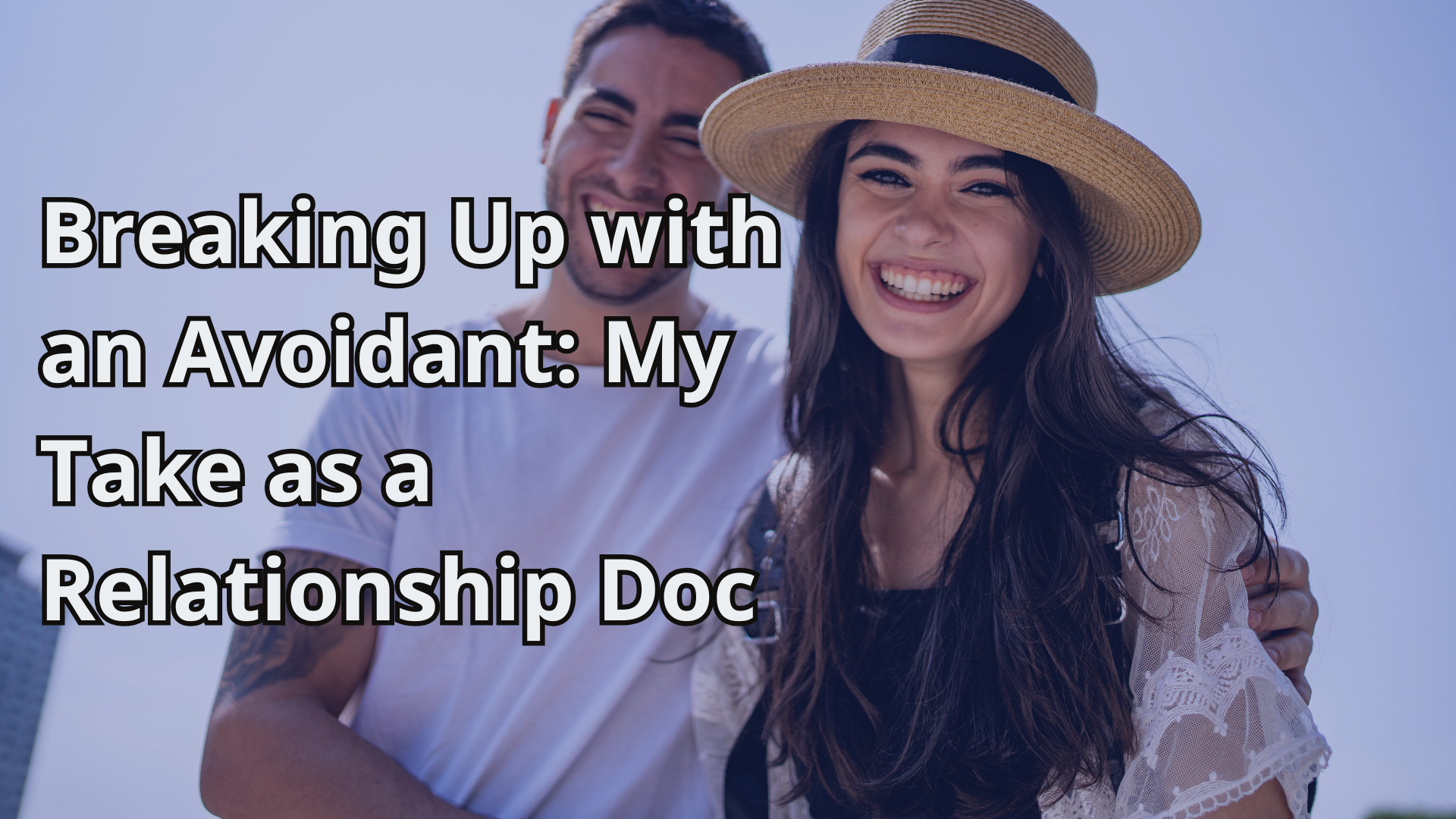Hey there, I’m Dr. Peggy Bolcoa, a marriage and family therapist with over 20 years under my belt helping folks sort out their love lives. I run my practice in Costa Mesa, California, where I see all kinds of people—singles, couples, families—dealing with the ups and downs of relationships. I stick to Emotionally Focused Therapy because it cuts through the noise and helps people connect for real.
Today, I want to talk about breaking up with an avoidant. If you’ve ever felt like your partner pulled away just when things got close, or if the breakup hit you out of nowhere, this might ring a bell. We’ll cover what avoidant attachment looks like, how avoidant attachments deal with breakups, what happens when an avoidant breaks up with you, avoidant attachment after breakup, and avoidant attachment style breakup. I’ll share tips from my work, some numbers from solid studies, and stories from couples I’ve helped. Let’s get into it.

Avoidants: Who Are They and Why Do They Act That Way?
First off, let’s break down avoidant attachment. It’s a way people handle closeness based on how they grew up. Kids who had parents that didn’t show much emotion or who pushed them to be independent often turn into adults who keep their distance in love. They value their space a lot and find it hard to open up. In my office, I see this all the time—folks who say they want a partner but freak out when someone gets too near.
About 25% of adults have this style, though recent trends show a jump in dismissive types by 56%. That’s a big deal in today’s world, where online dating makes it easy to swipe and ghost without facing feelings. Avoidants aren’t bad people; they just learned early on that relying on others hurts. So, they build walls. In relationships, they might seem cool and collected, but inside, they’re scared of losing control.
I remember telling one client, “You push people away not because you don’t care, but because caring feels too risky.” That hit home for him. If you’re dating one, you might notice they dodge talks about the future or pull back after a great date. It’s not you—it’s their wiring.
Red Flags: Signs You’re with an Avoidant
Spotting an avoidant early saves heartache. Here are five clear signs from my experience:
- They hate deep talks. If every chat about feelings turns into a joke or a topic change, that’s classic avoidant.
- Space is their best friend. They need alone time like air, and too much togetherness makes them bolt.
- Commitment? No thanks. Marriage or moving in? They drag their feet or say they’re “not ready.”
- Emotions stay hidden. They rarely say “I love you” or share what’s bugging them.
- They blame you for stuff. When things go south, it’s your fault for wanting too much.
In online dating, these signs pop up fast. Apps let avoidants flirt without strings, but when you want more, they vanish. A study shows people high in avoidance use dating apps more but end up with shallower connections. I’ve had clients swipe right on avoidants over and over, thinking the next one will stick. But patterns repeat unless you spot them.
The Breakup Bomb: When an Avoidant Breaks Up with You
Okay, let’s hit the tough part—when an avoidant breaks up with you. It’s often sudden, like a switch flips. One day you’re planning trips, the next they’re gone. Why? They feel trapped by closeness, so they end it to regain control. In my practice, I’ve seen this crush people. You wonder what you did wrong, but it’s their fear talking.
Avoidants initiate most breakups in these pairings because staying means facing emotions they hate. Post-split, they act fine, like nothing happened. But deep down? They’re hurting too, just not showing it. One stat: Insecure styles like avoidant predict higher divorce rates, with studies linking them to past splits. If you’re on the receiving end, it stings because they don’t give closure. No big fight, just “This isn’t working.”
I once had a woman come in after her avoidant boyfriend dumped her via text. She said, “He seemed happy last week!” I told her, “Avoidants run when feelings build. It’s not about you.” That helped her stop blaming herself.
Inside Their Head: How Do Avoidant Attachments Deal with Breakups?
Now, how do avoidant attachments deal with breakups? They shut down. Emotions? Buried. They distract with work, hobbies, or quick rebounds. Unlike anxious types who cry and call friends, avoidants pretend it’s no big deal. But research shows they feel pain later—sometimes weeks or months after. They might scroll through old photos in secret or regret it but never admit it.
In avoidant attachment style breakup, they avoid reflection. No journaling or therapy for them; that means admitting weakness. Instead, they tell themselves, “I’m better off alone.” But that keeps them stuck. If they broke up with you, they might hover online, liking posts but not reaching out. Online dating amps this up—apps offer endless options, so they jump ship fast without processing.
As I say in sessions, “Ignoring pain doesn’t make it go away; it just hides until it explodes.” Avoidants need to learn that, or they repeat the cycle.
The Aftermath: Avoidant Attachment After Breakup
Avoidant attachment after breakup looks calm on the surface, but it’s a storm inside. They might date someone new right away to fill the void, but those flings fizzle because they don’t fix the root issue. Studies show avoidants take longer to move on fully since they skip grieving. They could feel relief at first, then loneliness creeps in.
For the person left behind, avoidant attachment style after breakup means mixed signals. They might breadcrumb—random texts or views on your stories. In online dating scenes, this is rampant. Apps make it easy to check on exes without commitment. One client said her avoidant ex kept watching her Instagram but ignored messages. I advised, “Block him. He’s testing waters without jumping in.”
Avoidants rarely come back unless they hit rock bottom and seek help. Stats say dismissive types return less often than others. If they do, it’s because they miss the good parts but still fear the close ones.
From My Chair: Stories of Couples and Wild Cases
Over my 20+ years as a therapist, I’ve worked with hundreds of couples tangled in avoidant messes. Let me share some real stories—no names, of course—to show how this plays out.
First, there was this couple in their 30s. He had avoidant attachment from a cold childhood; she was anxious, always chasing. They met on a dating app, hit it off, but when she wanted labels, he ghosted for weeks. They broke up three times before coming to me. In EFT sessions, we dug into his fears. He admitted, “Closeness feels like a trap.” We practiced small steps, like sharing one feeling a day. Now? Married with kids. It wasn’t easy, but they broke the cycle.
Another case: A woman whose avoidant husband cheated after 10 years. He said it was “nothing,” but it was his way to escape intimacy. We worked on betrayal, and he learned to voice needs instead of acting out. She forgave, but only after he committed to change. I tell couples, “Affairs often stem from unmet emotions, not just lust.”
Then, a wild one—a guy who broke up with his girlfriend every time work stressed him. Avoidant to the core. He’d say, “I need space,” then regret it. We traced it to his dad’s abandonment. After months, he stopped the pattern. Last I heard, they’re engaged.
I’ve seen online dating twist things too. One client dated five avoidants in a row via apps. Each ghosted after a few dates. We talked about her patterns—attracting them because she chased hard. “Stop swiping on the aloof ones,” I said. She did, and found a secure partner.
In group work at the South Coast Center, where I was clinical director, we had sessions for breakups. Avoidants shared how they felt numb post-split, then crashed later. One man said, “I thought I was fine, but six months in, I cried alone.” That vulnerability changed him.
These cases taught me: Change happens when avoidants face fears head-on. As a Christian, I sometimes pray with clients who ask, but therapy works for all. I’ve helped atheists, Buddhists—everyone. The key? Nonjudgmental space.
Your Exit Plan: 8 Ways to Break Up with an Avoidant
If you’re the one ending it, breaking up with an avoidant takes guts. They might act indifferent, but it hurts them too. Here are eight steps from my toolkit:
- Pick a calm spot. No texts—face-to-face shows respect.
- Be direct. Say, “This isn’t working for me,” without blame.
- Expect silence. They won’t beg; they’ll nod and leave.
- Set boundaries post-breakup. No late-night calls.
- Process your side. Journal why it ended.
- Block if needed, especially online.
- Seek support. Talk to friends or a therapist.
- Learn for next time. Spot avoidants early.
In online dating, breakups happen via app deletes. But if it’s real, do it right. One stat: 36.7% of young adults face a breakup yearly, many avoidant-related. Don’t add to the pain—end kindly.
Mending Time: Healing After an Avoidant Split
Healing from avoidant attachment style breakup? It hurts, but you can bounce back. First, go no contact. Apps make it tempting to peek, but resist. Studies show anxious types (often paired with avoidants) feel worse from online checks.
Process feelings: Cry, yell, write. Challenge thoughts like “I’m not enough.” Self-care—walks, hobbies, friends. Therapy helps unpack patterns. In my sessions, we use EFT to rebuild security.
Avoid rebounds; date when ready. Online? Set standards—no ghosters. Build self-worth; you’re worthy of real love.
Busting Myths: Lies We Tell About Avoidant Breakups
People get a lot wrong about how avoidant attachments deal with breakups or what avoidant attachment after breakup really looks like. Let’s clear the air with facts from my sessions and solid research.
- Myth one: Avoidants don’t feel pain from splits. Wrong! They do hurt, but they stuff it down deep. In my practice, I’ve had avoidant clients admit months later that the breakup wrecked them, even if they seemed chill at first. One guy told me, “I acted like it was nothing, but nights alone hit hard.” Research backs this—avoidants repress distress right after, but it bubbles up later. When an avoidant breaks up with you, they might look fine, but inside, fear drives it.
- Myth two: They always come back begging. Nope, not usually. Avoidant attachment style after breakup means they value independence too much to chase. Stats show only a small chunk of avoidants return, and only if they work on themselves. I had a client wait six months for her ex to crawl back—he didn’t. She moved on, and that’s the real win.
- Myth three: Online dating fixes avoidant issues. Ha! Apps actually draw more avoidants. Men with avoidant styles flock to them, leading to shallow hooks. In my work, clients say apps make avoidant attachment style breakup cycles worse—ghosting galore. One woman shared, “Every swipe led to the same cold shoulder.” About 25% of adults are avoidant, but on apps, it feels higher because they thrive on low-commitment vibes.
- Myth four: You caused their avoidance. Not true—it’s from their past. But staying in the loop can drag you down. I tell folks, “Heal your side first.” Busting these myths helps you see clearly and dodge the traps.
Apps and Avoidants: The Digital Dating Trap
Online dating changed everything. Apps let avoidants dip in without risk. They chat, meet, then bail. A study links avoidance to blocked healthy bonds online. Anxious folks chase, avoidants run—classic trap.
I’ve written about this: Digital signals mislead. Likes aren’t love. Clients say apps amplify avoidant games. One woman met an avoidant on Tinder; he seemed great, then ghosted. “Why?” she asked. “Too much pressure,” he later admitted.
Stats show higher app use for insecure styles, but more bad experiences. My advice: Use apps wisely. Video calls early to spot walls. And remember, real connection beats swipes.
Second Chances: When Avoidants Come Back and How to Handle It
Now, let’s talk about what happens if that avoidant ex circles back—it’s rare, but it happens. In avoidant attachment after breakup, they might miss the perks without the pressure, so they test the waters. From my 20 years helping couples, I’ve seen a few pull it off, but only with real effort. Here’s the scoop on how do avoidant attachments deal with breakups when regret kicks in, and tips for you.
First, why return? Relief wears off, loneliness hits. Studies show avoidants feel the loss delayed, sometimes after new flings flop. One client, an avoidant man, broke up with his girlfriend, dated around online, then realized he wanted her back. He said, “Freedom felt empty.” But without change, it’s a repeat.
In online dating, this shows as lurks on your profile or random DMs. Apps make it easy for avoidants to hover without committing. A stat: People high in avoidance use dating sites more but report shallower bonds. If they reach out, ask for proof of growth—like therapy. I advise, “Don’t jump in blind; set rules.”
Success stories? Yep. A couple I worked with: She was secure, he was an avoidant. After he ended it, he hit therapy, learned to share feelings. They reunited, stronger. “EFT sessions saved us,” she told me. But failures too—one avoidant came back twice, bailed both times. Lesson: Spot red flags.
If you’re considering it, reflect: Has the avoidant attachment style breakup taught them? Demand open talks. In my experience, 1 in 5 avoidants who return stick if they commit to work. Otherwise, walk away. You deserve steady love, not games.
For those dumped, focus on you. Join groups, date secure types. Online? Look for consistent chatters, not flakers. As I say, “Past patterns predict the future—unless broken.”
Wrapping Up: My Advice as Your Therapist
As Dr. Peggy Bolcoa, I’ve seen avoidant breakups tear people apart, but also heal them stronger. Whether it’s how avoidant attachments deal with breakups or avoidant attachment after breakup, the key is understanding—yours and theirs. Don’t chase; build your security. If you’re avoidant reading this, know change is possible. Therapy works wonders.
In my 20 years, I’ve watched “impossible” couples thrive. You can too. If this hits home, reach out—my door’s open. Love doesn’t have to hurt forever.
FAQ: Quick Hits on Avoidant Breakups
How do avoidant attachments deal with breakups?
A: Avoidants shut down emotions and act like it’s no big deal. They distract with work or new dates, but pain hits later. In my sessions, they admit buried feelings to stay in control. Research shows they grieve delayed, often months after the split.
What happens when an avoidant breaks up with you?
A: It feels sudden and cold—no big fights, just a quick exit. They pull away to regain space. Post-breakup, they might breadcrumb with texts or likes, but rarely chase back. One stat: Avoidants start most breakups in mismatched pairs.
What does avoidant attachment after a breakup look like?
A: They seem fine on the outside, jumping into rebounds or hobbies. But inside, regret builds slowly. Online, they lurk on your profiles without reaching out. From my experience, this leads to lonely nights unless they get help.
How does avoidant attachment style affect you after breakup?
A: If you’re anxious, it leaves you chasing closure they won’t give. You might blame yourself. Heal by going no contact and building self-trust. I’ve helped clients spot this pattern to avoid it next time in dating apps.
What’s key in an avoidant attachment style breakup?
A: Understand it’s their fear, not your fault. Set boundaries, process your hurt, and learn signs for future loves. In 20 years of therapy, I’ve seen folks turn pain into stronger bonds—therapy makes the difference.

